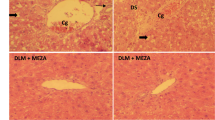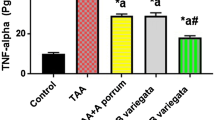Abstract
Anabasis articulata (Forssk) Moq. (Chenopodiaceae) is an herb, grows in Egypt, and used in folk medicine to treat diabetes, fever, and kidney infections. The protective and therapeutic effects of the ethanol extract of A. articulata aerial parts were evaluated against dimethylnitrosamine (DMN)-induced liver fibrosis, compared with the standard drug, silymarin. Hepatic hydroxyproline content, serum transforming growth factor-β1 (TGF-β1), interleukin 10 (IL-10) and fructosamine were measured as liver fibrosis markers. Hepatic malondialdehyde (MDA), nitric oxide (NO), catalase (CAT), glutathione reductase (GR) and glutathione content (GSH) were measured as oxidant/antioxidant markers. Parallel histopathological investigations were also performed. Protective and therapeutic administration of A. articulata (100 mg/kg daily for 4 weeks), markedly prevented DMN-induced loss in body and liver weights. The extract significantly inhibited the elevation of hepatic hydroxyproline, NO and MDA (P < 0.05), as well as serum fructosamine, and TGF-β1 (P < 0.05) induced by DMN while it restored IL-10 to normal level in both protective and therapeutic groups. Furthermore, A. articulata prevented the depletion in CAT, GR, and GSH levels (P ≤ 0.05). In addition, oral administration of A. articulata extract and silymarin to both protective and therapeutic groups reduced the increase in liver function enzyme activities; alanine and aspartate amintransferases, gamma-glutamyl transferase in addition to alkaline phosphatase, and caused significant increase in serum albumin concentration as compared to DMN group. These data corresponded closely with those obtained for the drug silymarin. Histopathological studies confirmed the biochemical data and revealed remarkable improvement in liver architecture. Thus, it could be concluded that, A. articulata extract exhibited in vivo hepatoprotective and therapeutic effects against DMN-induced liver injury and may act as a useful agent in controlling the progression of hepatic fibrosis through reduction of oxidative stress and improving liver function.




Similar content being viewed by others
References
Mello T, Ceni E, Surrenti C, Galli A. Alcohol induced hepatic fibrosis: role of acetaldehyde. Mol Aspects Med. 2008;29:17–21.
Saile B, Ramadori G. Inflammation, damage repair, liver fibrosis-role of cytokines and different cell types. Z Gastroenterol. 2007;45:77–86.
Huang Z, Willett WC, Colditz GA, Hunter DJ, Manson JE, Rosner B, et al. Waist circumference, waist: hip ratio, and risk of breast cancer in the Nurses’ Health Study. Am J Epidemiol. 1999;150:1316–24.
Misciagna G, De Michele G, Guerra V, Cisternino AM, Di Leo A, Freudenheim JL. Serum fructosamine and colorectal adenomas. Eur J Epidemiol. 2004;19:425–32.
Hattori Y, Kakishita H, Akimoto K, Matsumura M, Kasai K. Glycated serum albumin-induced vascular smooth muscle cell proliferation through activation of the mitogen-activated protein kinase/extracellular signal-regulated kinase pathway by protein kinase C. Biochem Biophys Res Commun. 2001;281(4):891–6.
Adrian JE, Poelstra K, Kamps JA. Addressing liver fibrosis with liposomes targeted to hepatic stellate cells. J Liposome Res. 2007;17:205–18.
Peng XD, Dai LL, Huang CQ, He CM, Chen LJ. Correlation between anti-fibrotic effect of baicalin and serum cytokines in rat hepatic fibrosis. World J Gastroenterol. 2009;15:4720–5.
Galli A, Svegliati-Baroni G, Ceni E, Milani S, Ridolfi F, Salzano R, et al. Oxidative stress stimulates proliferation and invasiveness of hepatic stellate cells via a MMP-2 mediated mechanism. Hepatology. 2005;41:1074–84.
Parola M, Robino G. Oxidative stress-related molecules and liver fibrosis. J Hepatol. 2001;35:297–306.
Haggerty HG, Holsapple MP. Role of metabolism in dimethylnitrosamine induced immune suppression: a review. Toxicology. 1999;63:1–23.
Magee PN, Barnes J. Carcinogenic nitroso compounds. Adv Cancer Res. 1967;10:163–246.
Suzuki K, Mitsuoka T. N-Nitrosamine formation by intestinal bacteria. IARC Sci Publ. 1984;57:275–81.
Pradeep K, Mohan CV, Gobianand K, Karthikeyan S. Effect of Cassia fistula Linn. leaf extract on diethylnitrosamine induced hepatic injury in rats. Chem Biol Interact. 2007;167(1):12–8.
Muriel P, Rivera-Espinoza Y. Beneficial drugs for liver diseases. J Appl Toxicol. 2008;28:93–103.
Sharmila Banu G, Kumar G, Murugesan AG. Effect of ethanolic leaf extract of Trianthema portulacastrum L. on aflatoxin induced hepatic damage in rats. Ind J Clin Biochem. 2009;24:414–8.
Levy C, Seeff LD, Lindor KD. Use of herbal supplements for chronic liver disease. Clin Gastroenterol Hepatol. 2004;2:947–56.
Jia JD, Bauer M, Cho JJ, Ruehl M, Milani S, Boigk G, et al. Antifibrotic effect of silymarin in rat secondary biliary fibrosis is mediated by downregulation of procollagen alpha1(I) and TIMP-1. J Hepatol. 2001;35:392–8.
Schuppan D, Porov Y. Hepatic fibrosis: from bench to bedside. J Gastroenterol Hepatol. 2002;17:S300–5.
Hammiche V, Maiza K. Traditional medicine in Central Sahara: pharmacopoeia of Tassili N’ajjer. J Ethnopharmacol. 2006;105:358–67.
Kambouche N, Merah B, Derdour A, Bellahouel S, Bouayed J, Dicko A, et al. Hypoglycemic and antihyperglycemic effects of Anabasis articulata (Forssk) Moq (Chenopodiaceae), an Algerian medicinal plant. Afr J Biotechnol. 2009;8:5578–83.
Segal R, Goldzweig-Milo I, Zaitschek DV. The sapogenin content of Anabasis articulata. Phytochemistry. 1969;8:521.
Alam EA. Phytochemical screening on different plant parts of some succulent plants of Egypt. N Y Sci J. 2011;4:15–8.
Kambouche N, Merah B, Derdour A, Bellahouel S, Younos C, Soulimani R. Antihyperglycemic activity of β-sitoglucosid sterol isolated from the plant of Anabasis articulata (Forssk) Moq. Phytothérapie. 2011;9:2–6.
Yen MH, Weng TC, Liu SY, Chai CY, Lin CC. The Hepatoprotective effect of Bupleurum kaoi, an endemic plant to Taiwan, against dimethylnitrosamine-induced hepatic fibrosis in rats. Biol Pharm Bull. 2005;28:442–8.
Geng J, Peng W, Huang Y, Fan H, Li S. Ginsenoside-Rg1 from Panax notoginseng prevents hepatic fibrosis induced by thioacetamide in rats. Eur J Pharmacol. 2010;634:162–9.
Metwally NS, Mohamed AM, ELSharabasy FS. Chemical constituents of the Egyptian Plant Anabasis articulata (Forssk) Moq and its antidiabetic effects on rats with streptozotocin induceddiabetic hepatopathy. J Appl Pharm Sci. 2012;2:54–65.
Jamall IS, Finelli VN, Que Hee SS. A simple method to determine nanogram levels of 4-hydroxyproline in biological tissues. Anal Biochem. 1981;112:70–5.
Schleicher ED, Vogt BW. Standardization of serum fructosamine assays. Clin Chem. 1990;36:136–9.
Moshage H, Kok B, Huizenga JR, Jansen PL. Nitrite and nitrate determinations in plasma: a critical evaluation. Clin Chem. 1995;41:892–6.
Ruiz-Larrea MB, Leal AM, Liza M, Lacort M, de Groot H. Antioxidant effects of estradiol and 2-hydroxyestradiol on iron-induced lipid peroxidation of rat liver microsomes. Steroids. 1994;59:383–8.
Lubinsky S, Bewley GC. Genetics of catalase in Drosophila melanogaster: rates of synthesis and degradation of the enzyme in flies aneuploid and euploid for the structural gene. Genetics. 1979;91:723–42.
Erden M, Bor NM. Changes of reduced glutathion, glutathion reductase, and glutathione peroxidase after radiation in guinea pigs. Biochem Med. 1984;31:217–27.
Moron MS, Depierre JW, Mannervik B. Levels of glutathione, glutathione reductase and glutathione S-transferase activities in rat lung and liver. Biochim Biophys Acta. 1979;582:67–78.
Strader DB, Bacon BR, Lindsay KL, La Brecque DR, Morgan T, Wright EC, et al. Use of complementary and alternative medicine in patients with liver disease. Am J Gastroenterol. 2002;97:2391–7.
Bansal M, Ananthanarayanan VS. The role of hydroxyproline in collagen folding: conformational energy calculations on oligopeptides containing proline and hydroxyproline. Biopolymers. 1988;1988(27):299–312.
Kim HK, Yang TH, Cho HY. Antifibrotic effects of green tea on in vitro and in vivo models of liver fibrosis. World J Gastroenterol. 2009;15:5200–5.
Oh SW, Kim DH, Ha JR, Kim DY. Anti-fibrotic effects of a methylenedioxybenzene compound, CW209292 on dimethylnitrosamine-induced hepatic fibrosis in rats. Biol Pharm Bull. 2009;32:1364–70.
Wang JH, Shin JW, Son JY, Cho JH, Son CG. Antifibrotic effects of CGX, a traditional herbal formula, and its mechanisms in rats. J Ethnopharmacol. 2010;127:534–42.
Lee HS, Jung KH, Park IS, Kwon SW, Lee DH, Hong SS. Protective effect of morin on dimethylnitrosamine-induced hepatic fibrosis in rats. Dig Dis Sci. 2009;54:782–8.
Liu H, Wei W, Sun WY, Li X. Protective effects of astragaloside IV on porcine-serum-induced hepatic fibrosis in rats and in vitro effects on hepatic stellate cells. J Ethnopharmacol. 2009;122:502–8.
Kim EY, Kim EK, Lee HS, Sohn Y, Soh Y, Jung HS, Sohn NW. Protective effects of Cuscutae semen against dimethylnitrosamine-induced acute liver injury in Sprague–Dawley rats. Biol Pharm Bull. 2007;30:1427–31.
Selvaraj N, Bobby Z, Sathiyapriya V. Effect of lipid peroxides and antioxidants on glycation of hemoglobin: an in vitro study on human erythrocytes. Clin Chim Acta. 2006;366:190–5.
Bauer M, Schuppan D. TGF beta1 in liver fibrosis: time to change paradigms? FEBS Lett. 2001;502:1–3.
Wells RG. The role of matrix stiffness in hepatic stellate cell activation and liver fibrosis. J Clin Gastroenterol. 2005;39:S158–61.
Tilg H, Kaser A, Moschen AR. How to modulate inflammatory cytokines in liver diseases. Liver Int. 2006;26:1029–39.
Kumar M, Sarin SK. Is cirrhosis of the liver reversible? Indian J Pediatr. 2007;74:393–9.
Wilasrusmee C, Kittur S, Shah G, Siddiqui J, Bruch D, Wilasrusmee S, et al. Immunostimulatory effect of Silybum Marianum (milk thistle) extract. Med Sci Monit. 2002;8:439–43.
Farombi EO, Shrotriya S, Surh YJ. Kolaviron inhibits dimethyl nitrosamine-induced liver injury by suppressing COX-2 and iNOS expression via NF-κB and AP-1. Life Sci. 2009;84:149–55.
Kim SK, Seo JM, Chae YR, Jung YS, Park JH, Kim YC. Alleviation of dimethylnitrosamine-induced liver injury and fibrosis by betaine supplementation in rats. Chem Biol Interact. 2009;177:204–11.
Beckman JS, Koppenol WH. Nitric oxide, superoxide, and peroxynitrite: the good, the bad, and the ugly. Am J Physiol. 1996;271:C1424–37.
Karafakioglu YS, Aslan R. Taurine prevents nonylphenol-induced oxidative stress in rats. J Anim Vet Adv. 2010;9:37–43.
Calabrese EJ, Canada AT. Catalase: its role in xenobiotic detoxification. Pharmacol Ther. 1989;44:297–307.
Noctor G, Foyer CH. Ascorbate and glutathione: keeping active oxygen under control. Annu Rev Plant Physiol Plant Mol Biol. 1998;49:249–79.
Wu G, Fang YZ, Yang S, Lupton JR, Turner ND. Glutathione metabolism and its implications for health. J Nutr. 2004;134:489–92.
Blair IA. Endogenous glutathione adducts. Curr Drug Metab. 2006;7:853–72.
Lee KJ, Choi JH, Kim HG, Han EH, Hwang YP, Lee YC, et al. Protective effect of saponins derived from the roots of Platycodon grandiflorum against carbon tetrachloride induced hepatotoxicity in mice. Food Chem Toxicol. 2008;46:1778–85.
Kiruthiga PV, Shafreen RB, Pandian SK, Devi KP. Silymarin protection against major reactive oxygen species released by environmental toxins: exogenous H2O2 exposure in erythrocytes. Basic Clin Pharmacol Toxicol. 2007;100:414–9.
Pradeep K, Mohan CV, Gobianand K, Karthikeyan S. Effect of Cassia fistula Linn. leaf extract on diethylnitrosamine induced hepatic injury in rats. Chem Biol Interact. 2007;167(1):12–8.
Ahmad R, Ahmed S, Khan NU, Hasnaina AU. Operculina turpethum attenuates N-nitrosodimethylamine induced toxic liver injury and clastogenicity in rats. Chem Biol Interact. 2009;181:145–53.
Ohara F, Nii A, Sakiyama Y, Tsuchiya M, Ogawa S. Pathophysiological characteristics of dimethylnitrosamine-induced liver fibrosis in acute and chronic injury models: a possible contribution of KLF5 to fibrogenic responses. Dig Dis Sci. 2008;53:2222–32.
Author information
Authors and Affiliations
Corresponding author
Rights and permissions
About this article
Cite this article
Mohamed, A.M., Abdalla, M.S., Rizk, M.Z. et al. Alleviation of Dimethylnitrosamine-Induced Liver Injury and Fibrosis by Supplementation of Anabasis articulata Extract in Rats. Ind J Clin Biochem 29, 418–429 (2014). https://doi.org/10.1007/s12291-013-0350-z
Received:
Accepted:
Published:
Issue Date:
DOI: https://doi.org/10.1007/s12291-013-0350-z




